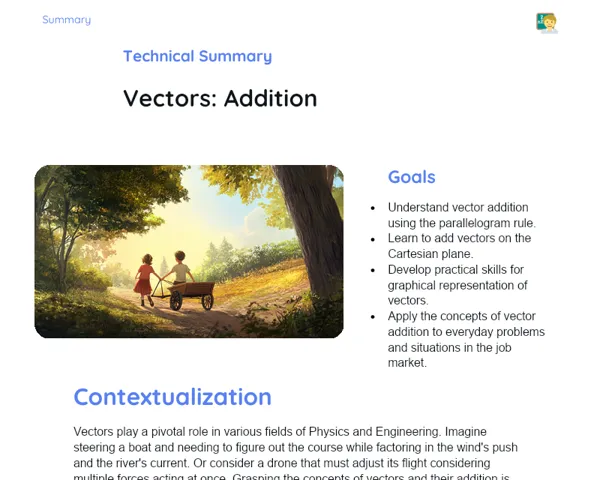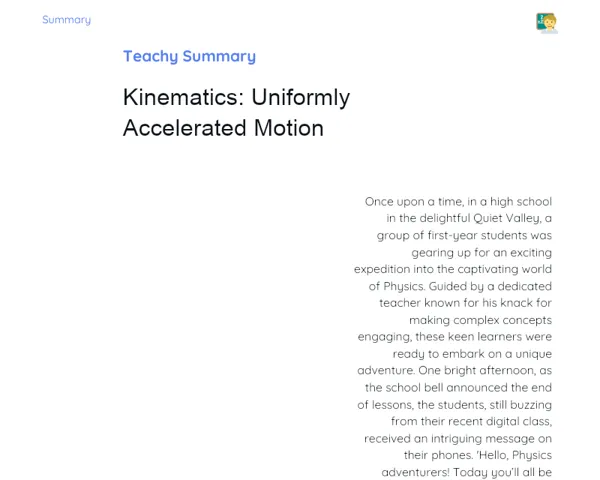Goals
1. Calculate the centripetal force of an object in curvilinear motion using the formula F=mv²/R.
2. Apply calculations of centripetal force to tackle mechanical problems, like a vehicle negotiating a curve on the road.
Contextualization
Picture a car zooming around a sharp bend. To prevent it from skidding off the road, a force must act on it to keep it along the curved path. This force is known as centripetal force. It is crucial not just for the safety of race cars on tracks but also in our day-to-day lives—think of thrilling rides at amusement parks or the orbits of satellites gliding around the Earth. Without centripetal force, high-speed turns would be impossible for vehicles, and satellites would drift aimlessly instead of maintaining their designated orbits.
Subject Relevance
To Remember!
Centripetal Force
Centripetal force refers to the force acting on an object that's moving in a curve, constantly pulling it towards the center of that curve. This force is essential for keeping the object on its curved path.
-
It always points towards the center of the circular path.
-
The strength of centripetal force relies on the object's mass, its speed, and the radius of the curve.
-
Without it, an object in motion would naturally move in a straight line due to inertia.
Centripetal Force Formula (F=mv²/R)
The formula F=mv²/R helps calculate the centripetal force. Here, F denotes the centripetal force, m represents the mass of the object, v is the object's speed, and R refers to the radius of the curve.
-
An increase in speed or mass results in a higher centripetal force.
-
The radius of the curve has an inverse relationship with centripetal force; a smaller radius necessitates a greater force.
-
This formula is crucial for addressing mechanical problems related to curvilinear movements.
Practical Applications of Centripetal Force
A solid understanding of centripetal force is important in areas like automotive engineering and applied physics. It ensures motor vehicle safety in turns and helps maintain stable satellite orbits.
-
In automotive engineering, centripetal force is vital for creating suspension systems and tires that enhance vehicle grip during turns.
-
In the aerospace field, calculating centripetal force is essential for determining satellite orbits, ensuring their operational longevity.
-
Amusement park rides use centripetal force in their design to guarantee the safety of patrons during circular motions.
Practical Applications
-
Engineers in motorsport design utilize centripetal force calculations to ensure that racing cars can navigate high-speed turns without losing grip.
-
Centripetal force is vital in satellite construction, allowing satellites to remain in steady orbit, which sustains communication and GPS functionalities.
-
In amusement parks, attractions like roller coasters and merry-go-rounds are engineered with centripetal force in mind to safeguard guests during their circular movements.
Key Terms
-
Centripetal Force: The force acting on an object in motion along a curve, directing it towards the center of the circular path.
-
Centripetal Force Formula (F=mv²/R): The equation used to compute centripetal force, where F is the force, m is the mass, v is the speed, and R is the radius of the curve.
-
Curvilinear Motion: The movement of an object along a curved trajectory.
-
Radius (R): The distance from the curve's center to a point on the object’s path in curvilinear motion.
Questions for Reflections
-
How does centripetal force impact vehicle safety during turns, and what measures can be adopted to improve this safety further?
-
In what other domains can the understanding of centripetal force be applied beyond automotive and aerospace sectors?
-
What difficulties arise while calculating centripetal force in various practical scenarios, and how can we tackle them?
Practical Challenge: Calculating Centripetal Force in Real-Life Situations
This mini-challenge aims to solidify your understanding of centripetal force by solving real-world problems and applying the theoretical concepts discussed during the lesson.
Instructions
-
Form groups of 3 to 4 students.
-
Select a real-life scenario where centripetal force is at play (e.g., a vehicle making a turn, a ride at an amusement park, or a satellite in orbit).
-
Research the relevant details (mass, speed, and radius of the curve) for your chosen scenario.
-
Utilize the formula F=mv²/R to determine the centripetal force in your selected situation.
-
Present your findings, illustrating how centripetal force affects safety and effectiveness in your chosen example.
-
Discuss within your group potential improvements or innovative solutions aimed at enhancing safety and efficiency based on your calculations.



